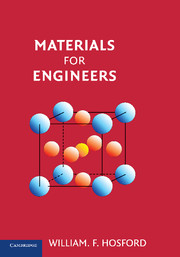Book contents
- Frontmatter
- Contents
- Preface
- 1 Introduction
- 2 Phases
- 3 Diffusion
- 4 Mechanical Behavior
- 5 Mechanical Failure
- 6 Annealing
- 7 Iron and Steel
- 8 Nonferrous Metals
- 9 Casting and Welding
- 10 Solid Shaping
- 11 Polymers
- 12 Polymer Processing
- 13 Glasses
- 14 Crystalline Ceramics
- 15 Powder Processing
- 16 Pottery and Concrete
- 17 Composites
- 18 Carbon
- 19 Fibers, Foams, and Porous Materials
- 20 Electrical Properties
- 21 Optical and Thermal Properties
- 22 Magnetic Materials
- 23 Corrosion
- 24 Modern Manufacturing Techniques, Surface Treatments, and Recycling
- APPENDIX 1 Wood
- APPENDIX 2 Miller Indices for Planes and Directions
- APPENDIX 3 X-ray Diffraction
- APPENDIX 4 Surfaces
- APPENDIX 5 Dislocations
- APPENDIX 6 Avrami Kinetics
- APPENDIX 7 Organic Chemistry
- APPENDIX 8 Average Molecular Weight
- APPENDIX 9 Bond Geometry in Compounds
- APPENDIX 10 Weibull Analysis
- Index
- Conversions
11 - Polymers
Published online by Cambridge University Press: 05 June 2012
- Frontmatter
- Contents
- Preface
- 1 Introduction
- 2 Phases
- 3 Diffusion
- 4 Mechanical Behavior
- 5 Mechanical Failure
- 6 Annealing
- 7 Iron and Steel
- 8 Nonferrous Metals
- 9 Casting and Welding
- 10 Solid Shaping
- 11 Polymers
- 12 Polymer Processing
- 13 Glasses
- 14 Crystalline Ceramics
- 15 Powder Processing
- 16 Pottery and Concrete
- 17 Composites
- 18 Carbon
- 19 Fibers, Foams, and Porous Materials
- 20 Electrical Properties
- 21 Optical and Thermal Properties
- 22 Magnetic Materials
- 23 Corrosion
- 24 Modern Manufacturing Techniques, Surface Treatments, and Recycling
- APPENDIX 1 Wood
- APPENDIX 2 Miller Indices for Planes and Directions
- APPENDIX 3 X-ray Diffraction
- APPENDIX 4 Surfaces
- APPENDIX 5 Dislocations
- APPENDIX 6 Avrami Kinetics
- APPENDIX 7 Organic Chemistry
- APPENDIX 8 Average Molecular Weight
- APPENDIX 9 Bond Geometry in Compounds
- APPENDIX 10 Weibull Analysis
- Index
- Conversions
Summary
Polymer is the technical term for what are commonly called plastics. Polymers consist of very large molecules. In fact, the word polymer comes from poly (for many) and mer (for parts). There are two main groups of polymers: thermoplastics, which are composed of linear molecules and will soften and melt when heated, and thermosetting polymers, whose molecules form three-dimensional framework structures. Thermosetting polymers will not melt or even soften appreciably when heated. The basic organic chemistry of bonding in polymers is treated in Appendix 7.
Thermoplastics
Thermoplastics consist of long chain molecules. The simplest of these have carbon-carbon backbones. The structure of polyethylene is illustrated schematically in Figure 11.1. Other linear polymers with carbon-carbon backbones are listed in Table 11.1.
Other thermoplastics have more complex backbones. Among these are nylon, polyester (PET), polycarbonate, cellulose, and poly(paraphenylene terephthalamide) or PPTA (also known as Kevlar®). Figure 11.2 illustrates the molecular structure of these.
Elastomers are rubber-like polymers. They have carbon backbones that include carbon-carbon double bonds. Figure 11.3 shows the repeating unit. The radicals, R, are listed in Table 11.2.
Silicones are polymers with -Si-O-Si-O- backbones.
Degree of Polymerization
The degree of polymerization is the average number of mer units per molecule. It is the molecular weight of the polymer divided by the molecular weight of the mer. There are two ways of describing the molecular weight: the number-average molecular weight, and the weight-average molecular weight. They are usually not very different but the weight average is always somewhat larger.
- Type
- Chapter
- Information
- Materials for Engineers , pp. 110 - 124Publisher: Cambridge University PressPrint publication year: 2008



